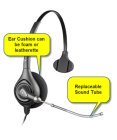


Headsets that connect to your telephone via a cable or cord have been around for many years. In fact the operators on the earliest switchboards used headsets.
Headsets with cords/cables can be considered as the "bread and butter" of the business and call centre headset industry. That is not to trivialise them. Cabled headsets account for more than 98% of telephone headset sales.
Headsets, like other considered "trivialities" in call centres and modern offices, are so very important but so often overlooked in their importance. Sifting through the available options to find the headsets that best fit your company is a difficult but necessary matter.
With significant investments being made to implement VoIP in contact centres, it's vital not to forget about the 'last metre' (i.e. The distance between your phone and your ear).

Telephone headsets have specific abilities required across the spectrum of small, large and home offices, enterprises and call centres of all sizes. No longer foreign attachments or alien appendages, these headsets are required contributors to the perceived quality of the call centre and enterprise. They should allow users to communicate with others, and they should do so clearly, distinctly and comfortably.
Headsets should offer the best that technology provides, and they should be made to last. They should be comfortable, versatile, compatible, cost-effective, reliable and, yes, perhaps even attractive. Above all, they should do exactly what you want for exactly the price you're willing to spend (if not more for that price).
This is a piece of equipment your employee has to wear, usually for long periods. It has to be comfortable. It must have great sound quality allowing them to easily hear and be heard . In larger organisations, it must be able to reduce conversations that may be occurring elsewhere in the office from being transmitted out to the customer.
Office and call centre headsets have a very large product range. This is not only due to the length of time that they have been around but is very much due to business needs and human preferences. The three classic cabled headset designs are:
Within the headset designs above are some features that are common to all three "families":
All headsets have consumables readily available. examples of these are new voice tubes, new ear muffs/cushions, new noise cancelling windscreens, new cables, etc. These are necessary both for simple repairs and (especially) hygiene. You can find a list of Plantronics accessories here.
Other hygienic items used in many call centres and offices are:
Even with the best designed products and the most careful handling, sometimes things go wrong. This guide has been designed to help you quickly and easily solve some of the most common headset questions and problems that you may encounter. .